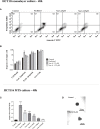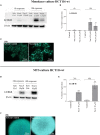Antiproliferative Effects of the Natural Oxadiazine Nocuolin A Are Associated With Impairment of Mitochondrial Oxidative Phosphorylation
- PMID: 31001482
- PMCID: PMC6456697
- DOI: 10.3389/fonc.2019.00224
Antiproliferative Effects of the Natural Oxadiazine Nocuolin A Are Associated With Impairment of Mitochondrial Oxidative Phosphorylation
Erratum in
-
Corrigendum: Antiproliferative effects of the natural oxadiazine Nocuolin A are associated with impairment of mitochondrial oxidative phosphorylation.Front Oncol. 2023 Jun 2;13:1228436. doi: 10.3389/fonc.2023.1228436. eCollection 2023. Front Oncol. 2023. PMID: 37333819 Free PMC article.
Abstract
Natural products are interesting sources for drug discovery. The natural product oxadiazine Nocuolin A (NocA) was previously isolated from the cyanobacterial strain Nodularia sp. LEGE 06071 and here we examined its cytotoxic effects against different strains of the colon cancer cell line HCT116 and the immortalized epithelial cell line hTERT RPE-1. NocA was cytotoxic against colon cancer cells and immortalized cells under conditions of exponential growth but was only weakly active against non-proliferating immortalized cells. NocA induced apoptosis by mechanism(s) resistant to overexpression of BCL family members. Interestingly, NocA affected viability and induced apoptosis of HCT116 cells grown as multicellular spheroids. Analysis of transcriptome profiles did not match signatures to any known compounds in CMap but indicated stress responses and induction of cell starvation. Evidence for autophagy was observed, and a decrease in various mitochondrial respiration parameter within 1 h of treatment. These results are consistent with previous findings showing that nutritionally compromised cells in spheroids are sensitive to impairment of mitochondrial energy production due to limited metabolic plasticity. We conclude that the antiproliferative effects of NocA are associated with effects on mitochondrial oxidative phosphorylation.
Keywords: anti-cancer drugs; autophagy; colon cancer; cyanobacteria; mitochondria; natural products; spheroids.
Conflict of interest statement
The authors declare that the research was conducted in the absence of any commercial or financial relationships that could be construed as a potential conflict of interest.
Figures





Similar articles
-
The Cyanobacterial Oxadiazine Nocuolin A Shows Broad-Spectrum Toxicity Against Protozoans and the Nematode C. elegans.Microb Ecol. 2025 Mar 4;88(1):9. doi: 10.1007/s00248-025-02507-2. Microb Ecol. 2025. PMID: 40035794 Free PMC article.
-
Corrigendum: Antiproliferative effects of the natural oxadiazine Nocuolin A are associated with impairment of mitochondrial oxidative phosphorylation.Front Oncol. 2023 Jun 2;13:1228436. doi: 10.3389/fonc.2023.1228436. eCollection 2023. Front Oncol. 2023. PMID: 37333819 Free PMC article.
-
Antifouling activity and ecotoxicological profile of the cyanobacterial oxadiazine nocuolin A.Chemosphere. 2024 Oct;365:143318. doi: 10.1016/j.chemosphere.2024.143318. Epub 2024 Sep 11. Chemosphere. 2024. PMID: 39271082
-
Targeting Mitochondrial Function to Treat Quiescent Tumor Cells in Solid Tumors.Int J Mol Sci. 2015 Nov 13;16(11):27313-26. doi: 10.3390/ijms161126020. Int J Mol Sci. 2015. PMID: 26580606 Free PMC article. Review.
-
Modulation of mitochondrial functions by the indirect antioxidant sulforaphane: a seemingly contradictory dual role and an integrative hypothesis.Free Radic Biol Med. 2013 Dec;65:1078-1089. doi: 10.1016/j.freeradbiomed.2013.08.182. Epub 2013 Aug 30. Free Radic Biol Med. 2013. PMID: 23999506 Review.
Cited by
-
Structural characteristic of polysaccharide isolated from Nostoc commune, and their potential as radical scavenging and antidiabetic activities.Sci Rep. 2022 Dec 22;12(1):22155. doi: 10.1038/s41598-022-26802-x. Sci Rep. 2022. PMID: 36550164 Free PMC article.
-
Novel Marine Secondary Metabolites Worthy of Development as Anticancer Agents: A Review.Molecules. 2021 Sep 23;26(19):5769. doi: 10.3390/molecules26195769. Molecules. 2021. PMID: 34641312 Free PMC article. Review.
-
Decoding Lusichelins A-E: An In-Depth Look at the Metallophores of Lusitaniella coriacea LEGE 07167-Structure, Production, and Functionality.J Nat Prod. 2025 Jun 27;88(6):1319-1333. doi: 10.1021/acs.jnatprod.5c00204. Epub 2025 May 21. J Nat Prod. 2025. PMID: 40398867 Free PMC article.
-
Blue-Print Autophagy in 2020: A Critical Review.Mar Drugs. 2020 Sep 21;18(9):482. doi: 10.3390/md18090482. Mar Drugs. 2020. PMID: 32967369 Free PMC article. Review.
-
Uncovering the Bioactive Potential of a Cyanobacterial Natural Products Library Aided by Untargeted Metabolomics.Mar Drugs. 2021 Nov 12;19(11):633. doi: 10.3390/md19110633. Mar Drugs. 2021. PMID: 34822504 Free PMC article.
References
-
- Kim K-W, Roh JK, Wee H-J, Kim C. Natural Product Anticancer Drugs. Cancer Drug Discovery: Science and History. Dordrecht: Springer Netherlands; (2016). p. 113–34. 10.1007/978-94-024-0844-7_6 - DOI
-
- Brito Â, Gaifem J, Ramos V, Glukhov E, Dorrestein PC, Gerwick WH, et al. . Bioprospecting portuguese atlantic coast cyanobacteria for bioactive secondary metabolites reveals untapped chemodiversity. Algal Res. (2015) 9:218–26. 10.1016/j.algal.2015.03.016 - DOI

